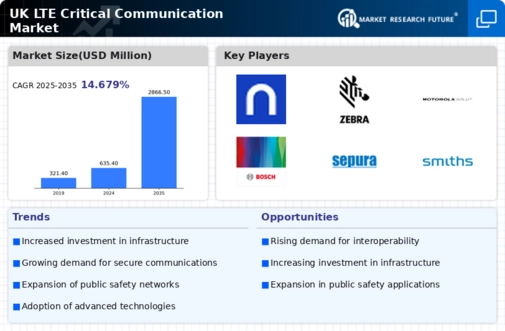The lte critical-communication market is characterized by a dynamic competitive landscape, driven by the increasing demand for reliable communication systems across various sectors, including public safety, transportation, and utilities. Key players such as Motorola Solutions (US), Thales Group (FR), and Ericsson (SE) are strategically positioned to leverage their technological expertise and extensive portfolios. Motorola Solutions (US) focuses on innovation in mission-critical communications, emphasizing the integration of AI and data analytics into their offerings. Thales Group (FR) is enhancing its capabilities through partnerships and regional expansions, particularly in Europe, to cater to the growing needs of government and defense sectors. Meanwhile, Ericsson (SE) is concentrating on digital transformation initiatives, aiming to optimize network performance and enhance user experience, thereby shaping a competitive environment that prioritizes technological advancement and customer-centric solutions.
The market structure appears moderately fragmented, with several players vying for market share through various business tactics. Companies are increasingly localizing manufacturing to reduce costs and improve supply chain efficiency. This strategy not only enhances responsiveness to market demands but also mitigates risks associated with global supply chain disruptions. The collective influence of key players fosters a competitive atmosphere where innovation and operational efficiency are paramount, driving the market towards more sophisticated communication solutions.
In October 2025, Motorola Solutions (US) announced a strategic partnership with a leading AI firm to enhance its critical communication systems. This collaboration aims to integrate advanced AI capabilities into their existing platforms, potentially revolutionizing how emergency services respond to incidents. The strategic importance of this move lies in its potential to improve situational awareness and decision-making processes, thereby enhancing public safety outcomes.
In September 2025, Thales Group (FR) launched a new suite of secure communication solutions tailored for the defense sector. This initiative reflects Thales's commitment to addressing the unique challenges faced by military and governmental organizations. By focusing on security and interoperability, Thales positions itself as a leader in providing robust communication systems that meet stringent regulatory requirements, which could significantly bolster its market presence.
In August 2025, Ericsson (SE) unveiled a new digital platform designed to optimize network management for critical communications. This platform leverages machine learning to predict network issues before they arise, thereby ensuring uninterrupted service. The strategic significance of this development lies in its potential to enhance reliability and efficiency, which are crucial for mission-critical applications.
As of November 2025, the competitive trends in the lte critical-communication market are increasingly defined by digitalization, sustainability, and the integration of AI technologies. Strategic alliances are becoming more prevalent, as companies recognize the need to collaborate to enhance their technological capabilities and market reach. Looking ahead, competitive differentiation is likely to evolve from traditional price-based competition to a focus on innovation, technological advancements, and supply chain reliability. This shift underscores the importance of developing cutting-edge solutions that not only meet current demands but also anticipate future challenges in the critical communication landscape.






















Leave a Comment